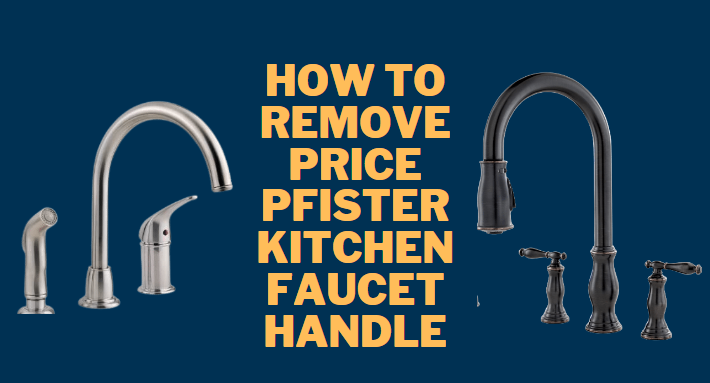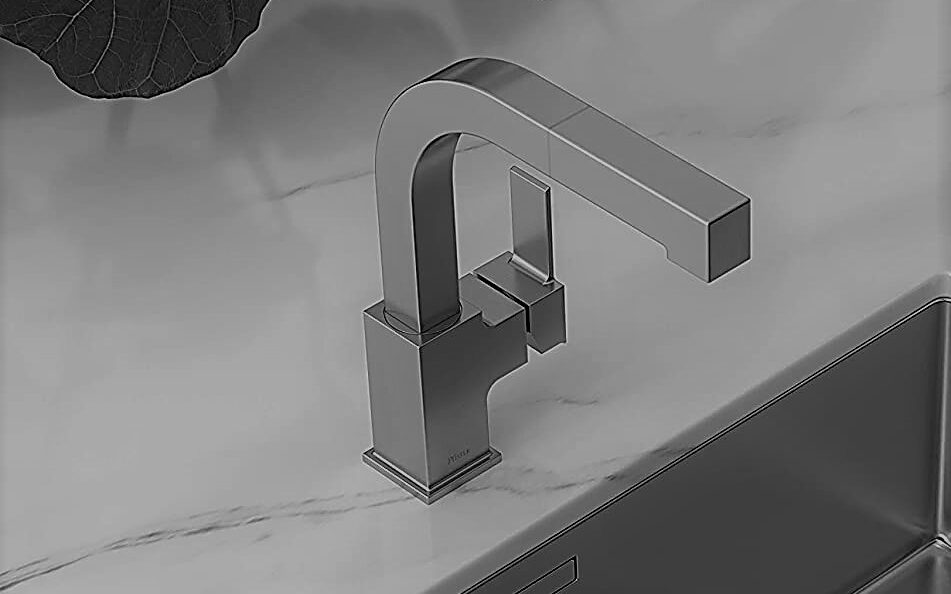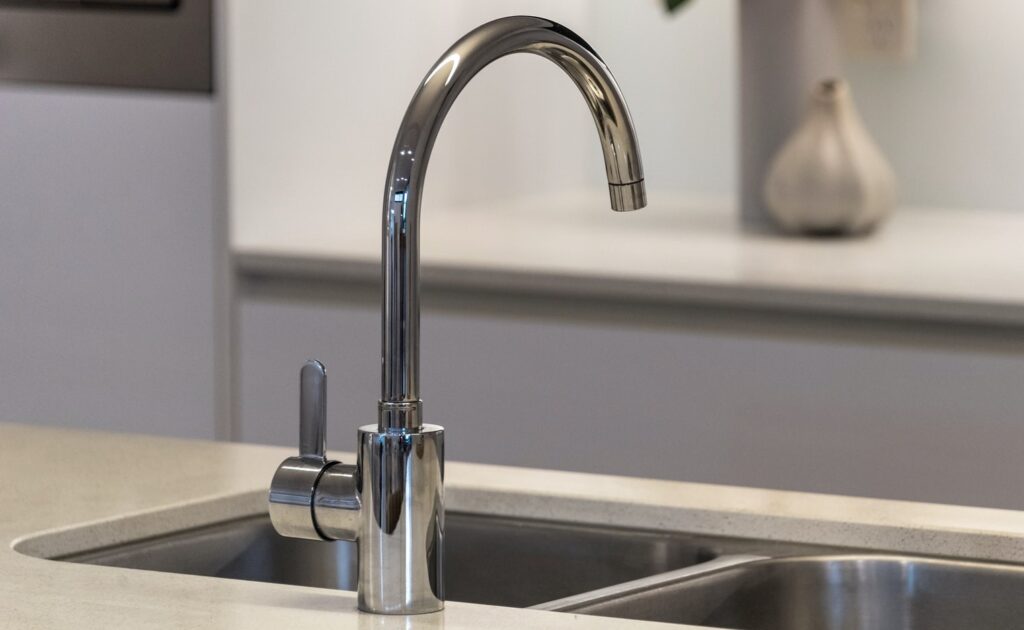
If you’re like most homeowners, you probably use your kitchen faucet several times a day. So if it starts to malfunction, it can be pretty frustrating. One common issue that people experience with kitchen faucets is that the handle becomes loose and won’t stay in place.
In this blog post, we’ll show you how to remove the Price Pfister kitchen faucet handle so that you can tighten it or replace it if necessary. Keep reading for instructions on how to do this yourself!
- A Step Guide: How to Remove Price Pfister Kitchen Faucet Handle
- Empty the sink cabinet
- Turn off the water source
- Remove the handle and its hub
- Disconnect the hoses
- Remove the quick connect
- Detach the spout mounting hardware
- Detach product from the sink
- Check for leaks after the new Installation
- Factors To Consider When Choosing The Kitchen Faucet
- FAQs
A Step Guide: How to Remove Price Pfister Kitchen Faucet Handle

Empty the sink cabinet
In the first step of ”How to remove Pfister kitchen faucet”, it is important to clear out the sink cabinet beneath the sink. This will give you easy access to the handle and make it easier to remove. To do this, simply open the cabinet doors and remove any items that are stored inside.
Once the cabinet is empty, you should be able to easily reach the handle and remove it without any difficulty. With the handle removed, you will then be able to access the inner workings of the faucet and make any necessary repairs or replacements.
Turn off the water source
Before attempting to remove a Price Pfister kitchen faucet handle, it is important to first turn off the water source. This will help to prevent any accidental leaks or flooding. To do this, simply locate the valve under the sink and turn it clockwise until it is completely closed. Once the water is turned off, you can proceed with removing the handle.
Remove the handle and its hub
In order to remove the handle and its hub from a Price Pfister kitchen faucet, first, use a screwdriver or Allen wrench to loosen the setscrew located under the lever. Once the setscrew is loosened, pull the lever off of the stem. Next, use a crescent wrench to loosen the packing nut located under the lever.
Once the packing nut is loosened, remove the handle by pulling it straight off of the stem. Finally, use a pair of pliers to remove the hub by unscrewing it from the stem. With the handle and hub removed, you will now be able to access the inner workings of the faucet for repairs or replacement.
Disconnect the hoses
After you have removed the Price Pfister kitchen faucet handle, it is important to disconnect the hoses before proceeding any further. There are two hoses located underneath the sink, one for hot water and one for cold water. To disconnect the hoses, simply unscrew the nut or turn the lever to release the hose.
Once the hoses are disconnected, you will be able to remove the faucet without having to worry about water spilling everywhere.
Remove the quick connect
After removing the Price Pfister kitchen faucet handle, there is a quick connection that needs to be removed in order to take the faucet apart. The quick connect is located under the sink. There is a small black knob that needs to be turned counterclockwise in order to loosen it. Once the knob is turned, the quick connect can be pulled out from under the sink.
Be careful not to lose any of the parts that come with the quick connect. After the quick connect is removed, the faucet can be taken apart for cleaning or repairs.
Detach the spout mounting hardware
Working on ”How to Remove Price Pfister Kitchen Faucet Spout” starts with the small retaining clip holding the spout in place. Use a flathead screwdriver to pry the clip off, then remove the spout. Next, use a Phillips head screwdriver to remove the two screws that are holding the handle in place. Once the screws are removed, you should be able to pull the handle off.
With the handle removed, you’ll now be able to access the valve stem. To remove it, simply unscrew it counterclockwise with a pair of pliers. Once the valve stem is removed, you can now take off the escutcheon plate. This is held in place by two more screws. Remove them with a Phillips head screwdriver, then lift off the escutcheon plate.
You should now have full access to the back of the faucet.
Detach product from the sink
Finally, remove the Price Pfister kitchen faucet handle, and detach it from the sink. You may need to use a screwdriver to remove the handle. Be careful not to damage the finish on the handle or the faucet. Once the handle is detached, you can then remove the screws that hold the faucet in place.
Be sure to keep track of all the parts as you disassemble the faucet. This will make it easier to reassemble the faucet when you are ready to install it in your new kitchen. Follow these simple steps and you will have your old kitchen faucet removed in no time.
Check for leaks after the new Installation
After you have installed a new faucet handle, it is important to check for leaks. First, turn on the water at the shut-off valve and make sure that the handle is in the off position. Then open the faucet to allow any air out of the lines. Next, turn on the water and check under the sink for any leaks. If you see any water leaking from the base of the faucet or from the connection between the supply line and the shut-off valve, tighten the connection with a wrench.
Finally, turn off the water at the shut-off valve and open the faucet to check that the leak has stopped. If you still see water leaking, repeat this process until the leak has been fixed.
Factors To Consider When Choosing The Kitchen Faucet

Material
When selecting a kitchen faucet, there are a number of factors that must be considered in order to ensure that the right choice is made. The first thing to consider is the material from which the faucet is made. The most common materials used for kitchen faucets are brass, stainless steel, and copper. Each of these materials has its own advantages and disadvantages, so it is important to select the material that best suits the needs of the kitchen.
Installation
When it comes to choosing a kitchen faucet, ease of installation must be considered. After all, no one wants to spend hours trying to install a new faucet only to end up with a leaky mess. To avoid this headache, look for a faucet that comes with easy-to-follow instructions and all the necessary hardware. Another installation consideration is the type of sink you have.
If you have a top-mount sink, make sure to choose a faucet that is compatible. Lastly, take into account the number of holes in your sink. Most faucets require three holes, but some only require two. Keep these installation considerations in mind when selecting your kitchen faucet to ensure a smooth and hassle-free installation process.
Maintenence
When choosing a kitchen faucet, it is important to consider not only the initial cost but also the long-term costs of maintenance and repair. A cheap faucet may seem like a good deal at first, but if it breaks frequently or is difficult to keep clean, it can end up costing more in the long run. On the other hand, a more expensive faucet may last longer and be easier to maintain, ultimately saving money over time. Therefore, it is important to strike a balance between initial cost and long-term affordability when selecting a kitchen faucet.
Handle style
When choosing a kitchen faucet, handle style is an important consideration. There are several common handle styles, each with its own advantages and disadvantages. Lever handles are a popular choice for their classic look and easy operation. However, they can be difficult to use if your hands are dirty or sticky.
Cross handles offer a more traditional appearance, but they can be challenging to grip if your hands are wet. Knob handles are easy to grip and operate, but they may not provide the same level of precision as other handle styles. Ultimately, the best handle style for your kitchen faucet depends on your personal preferences and needs.
Spout type
The three most common types of spouts are straight, gooseneck, and high-arc. Straight spouts are the simplest design and are often the most affordable option. Gooseneck spouts have a tall, arched neck that allows for greater clearance beneath the faucet. High-arc spouts have an even taller neck and are often used in commercial applications.
Colour and finish
Finish and color are 2 important factors to consider when you are about to buy kitchen faucets. Do you want a classic stainless steel look, or something more modern? There are also a variety of finishes available, from brushed to polished. Next, you’ll need to choose the right color. Again, this is largely a matter of personal preference.
However, it’s worth considering whether you want the faucet to blend in with your other hardware, or make a statement. Finally, you’ll need to think about functionality. What type of sprayer do you need? What type of handle do you prefer? With so many options available, it’s important to take your time and choose the right faucet for your kitchen. Check out this Pfister kitchen faucet.
FAQs
How do you remove a lever faucet handle?
To remove a lever faucet handle, start by turning off the water supply to the faucet. Then, use a wrench to loosen the set screw that holds the handle in place. Once the set screw is removed, the handle should come off easily. If it doesn’t, you may need to use a utility knife to gently pry it off.
How do you tighten a Price Pfister kitchen faucet?
Locate the set screw on the underside of the handle. This will be a small Phillips head screw. Use a Phillips head screwdriver to tighten the setscrew until it is snug. Next, check the base of the spout for any visible screws. If there are screws, use a wrench to tighten them until they are snug.
What to do if the Pfister kitchen faucet handle gets stuck?
Try gently tapping the handle with a hammer. If that doesn’t work, use a wrench or pliers to apply some leverage. Once the handle is loose, regularly oil it to prevent it from getting stuck again in the future.
Check out the reading on the best touchless bathroom faucet.